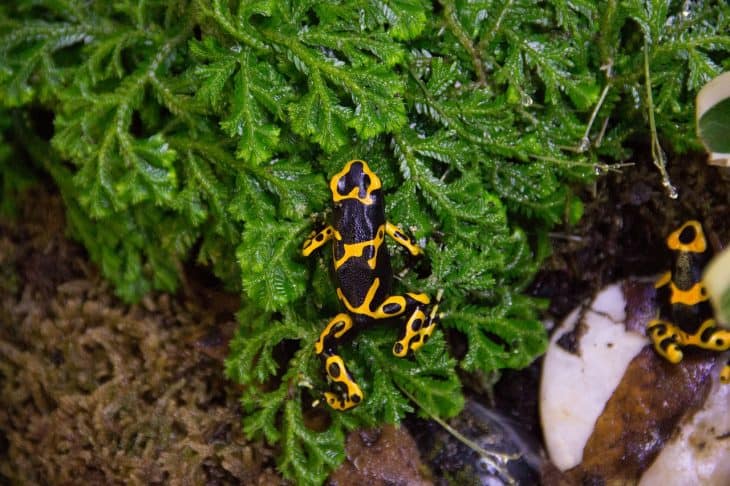
Poison dart frogs have some of the most vibrant and beautiful colors on the planet. Depending on where they live, which extends from the tropical forests of Costa Rica to Brazil, their coloring can be gold or copper. Based on various poison dart frog facts, some of them can also be green, red, blue, and even black. To fend off potential predators, their intricate patterns and colors are purposefully ostentatious.
Don’t let their beautiful colors fool you, though. Poison dart frogs are some of the most deadly animals in the rainforest. This less than 1-inch species contains poison that can kill animals, humans, and other threats who will try to harm or touch them. Poison dart frogs catch their prey in a variety of ways. Slurp up! With a long, sticky tongue that can dart out, poison dart frogs can easily capture fruit flies, ants, termites, young crickets, and tiny beetles.
Here’s another interesting fact – did you know that medical researchers are extracting chemicals from the skin of poison dart frogs to make painkillers? It is reportedly 200 times stronger than morphine! Interested in these beautiful but deadly creatures? Discover more of their other amazing characteristics with these poison dart frog facts!
- Poison dart frog measures 1.5 cm (0.59 in) once mature.
- They weigh an average of 1 ounce or 28 grams.
- Some species of poison dart frog existed around 6,000 years ago.
- There are about 200 species of poison dart frogs.
- Some species grow up to 6 centimeters or 2.4 inches in length.
- Poison dart frogs are originally known as poison arrow frogs.
- Poison dart frogs are some of the most deadly animals on Earth.
- The poison dart frog belongs to the Dendrobatidae family. Those that belong to this family are mostly seen in Central and South America.
- Poison dart frogs are amphibians.
- They can live for over 10 years.
- Poison dart frogs are active during the daytime.
- They live in a habitat where the temperature is around 22°C to 27°C.
- Poison dart frogs use their long and sticky tongue to capture prey.
- Poison dart frogs produce a variety of sounds.
- The color of the poison dart frog range from blue, black, and green. There also are tri-colored frogs.
- Leimadophis Epinephelus or fire-bellied snakes are immune to poison dart frogs.
- Each specimen of the poison dart frog produces different types of toxins.
- The brighter-colored poison dart frogs are more poisonous.
- Poison dart frogs have excellent eyesight which helps them locate prey.
- The name “poison dart frog” came from the Choco people of western Colombia. They would use the frog’s poison as a coating for their blow darts when hunting.
Scientists believe that their poison comes from the food they eat.
Scientists believe that a poison dart’s diet contributes greatly to the poison that they have. This is one reason why poison dart frogs in zoos are not poisonous. Poison dart frogs in the wild mainly feed on ants, mites, termites, centipedes, and small beetles. While poison dart frogs that live in captivity consume crickets, fruit flies, and other non-poisonous insects.
Golden poison frog is the most dangerous species of poison dart frog.

The golden poison frog is the most poisonous of all the species of poison dart frog. They contain approximately one milligram of the poison batrachotoxin, a toxin secreted in the glands of poisonous frogs. It is enough to kill 10 adult men or 10,000 mice.
The toxin of poison dart frog can kill you within three minutes.
Poison dart frog’s toxin can cause death within three minutes after exposure. It may cause nausea, paralysis, and even heart failure, which could be fatal. There are no known antidotes for the toxin of the poison dart frog.
Poison dart frogs use their colors to warn predators.
Poison dart frogs use a defense mechanism called “aposematic coloration.” This means that their color warns predators of possible danger if they will touch or eat them. Within the skin, they contain toxins that may harm or kill a predator.
Courting of poison dart frogs lasts for hours.
Courtship of poison dart frogs usually lasts for hours. It begins with males calling or making sounds, chasing, hopping, and caressing one another. A female poison dart frog lays small clutches of eggs, with about 30 soft eggs deposited on leaves on trees and sometimes on the ground.
Hatchlings usually take 10 to 18 days.
Poison dart frogs are unique among the other amphibians because both male and female poison dart frogs take care and guard the eggs. Hatchlings usually take place between 10 to 18 days, depending on the species and the temperature. Once the eggs are hatched, their parents would carry them on their backs and bring them to running water.
The only predator of the poison dart frog is the Fire-Bellied snake.
Due to the toxins that the poison dart frog contains, their only natural predator is the Leimadophis Epinephelus, or what is known as the fire-bellied snake. It is believed that a substance in the saliva of the fire-bellied snake removes the toxin of the poison dart frog.
Some species of poison dart frogs are threatened or endangered.
Approximately 25% of the 200 species of poison dart frogs are listed as threatened or critically endangered. Several reasons that impact the decreasing numbers of poison dart frogs including human activities, pollution, loss of habitat, and fungal diseases.
Poison dart frogs are being smuggled.
Some collectors go after new and rare species of poison dart frogs. Smugglers export them illegally by hiding them in their luggage. According to customs officials, about 90% of illegally transported poison dart frogs die due to poor shipping conditions.
Experts see their poison as a potential medicine.

Medical researchers are exploring the probable medicinal use of poison dart frogs. Some scientists use the chemical extracted from the skin of poison dart frog to make painkillers. Even more, they say that epibatidine (a chemical secreted from the skin of poison dart frog) is 200 times powerful as morphine.
Was this page helpful?
Our commitment to delivering trustworthy and engaging content is at the heart of what we do. Each fact on our site is contributed by real users like you, bringing a wealth of diverse insights and information. To ensure the highest standards of accuracy and reliability, our dedicated editors meticulously review each submission. This process guarantees that the facts we share are not only fascinating but also credible. Trust in our commitment to quality and authenticity as you explore and learn with us.
